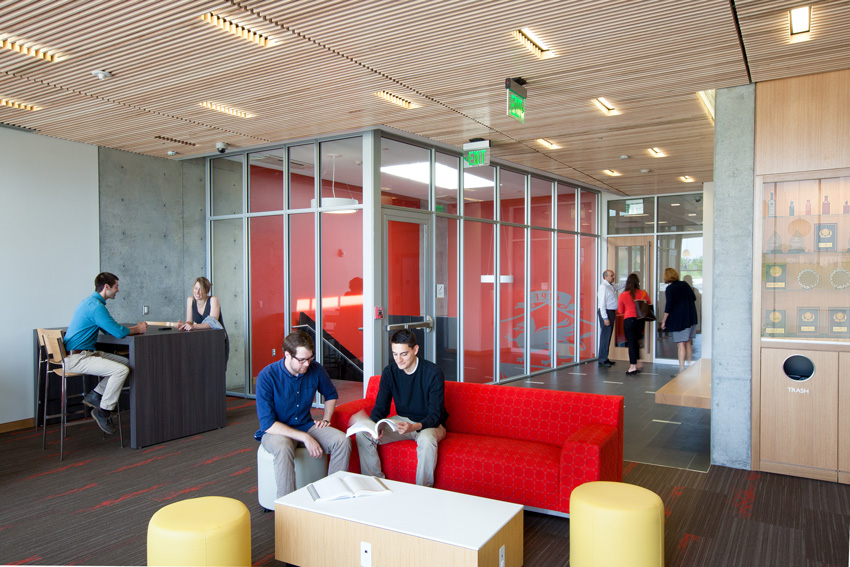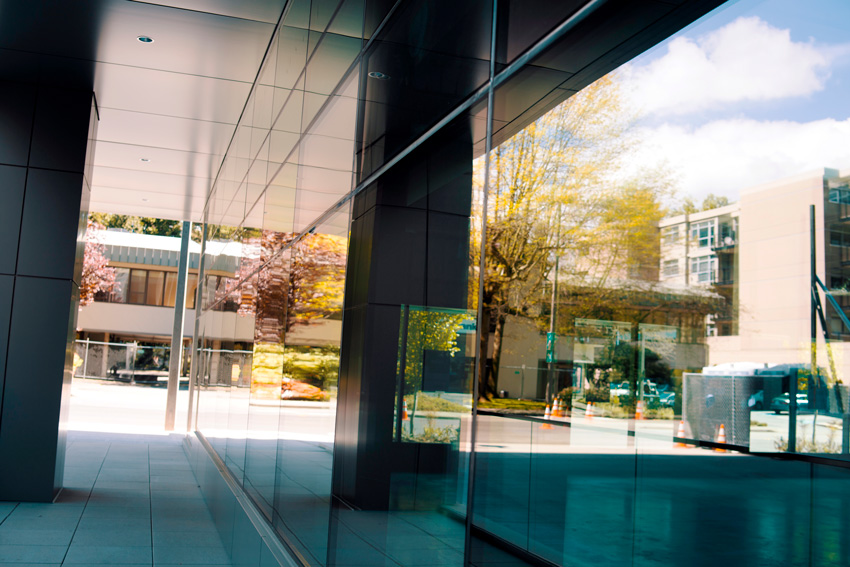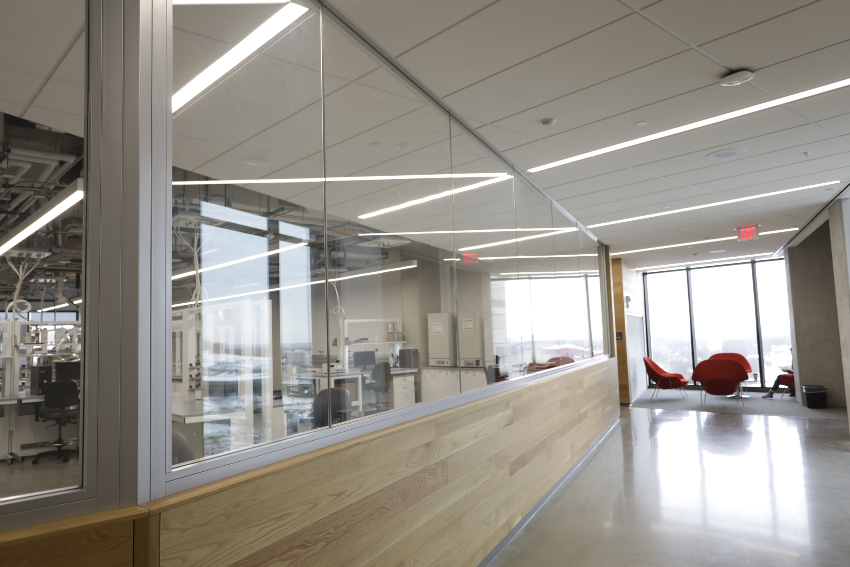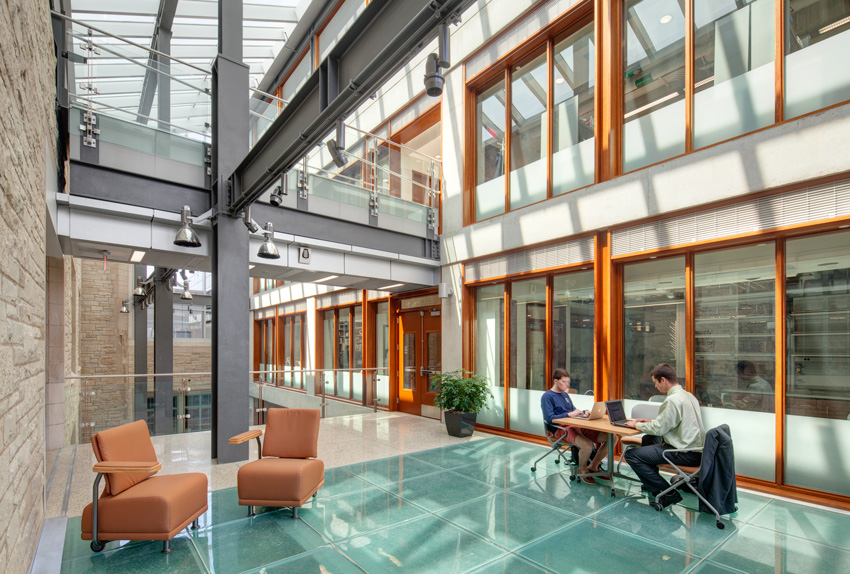The Future of Fire-Rated Glass and Framing
Frame Cover Caps and Finishes
In addition to specifying narrow fire-rated frames, designers can select from a wide array of versatile frame cover caps and finishes to help match fire-rated frames to nonrated frames used in other parts of the building. This means that architects can now more closely mirror the aesthetic of nonrated systems, providing greater design freedom. In terms of the appearance of fire-rated frames, there are ever-expanding opportunities for building teams to achieve virtually any look to complement non-fire-rated frames. This “match” can be accomplished in a number of ways, including:
Custom paints or powder coats: Frames can be custom painted, anodized, or powder coated to match nearly any color scheme. This includes the more traditional material matches like the silver color of aluminum to bold colors like purples and reds.
Materials and cover caps: Designers now have fire-rated frame options ranging from authentic hardwood to products with the look of stainless steel. For example, one popular finish option is durable stainless steel. It matches the bright, contemporary aesthetic of stainless steel used in other building finishes. Fire-rated frames are also available with custom aluminum cover caps for a cohesive look.
Shapes and sizes: The face caps are available in numerous shapes and sizes, from H and I shapes to custom configurations.
Alternatively, while achieving a seamless, complementary visual match between fire-rated and non-fire-rated elements is an important design goal, other building projects demand a way to differentiate designs through framing. This can be achieved through various options, including the installation of fire-rated glass and frames featuring custom corners and angles, which is one way to create a visual point of interest while working within the parameters of code-driven applications. Additionally, custom finishes (e.g., wet painting or powder coating carbon steel frames in a variety of colors) can be used to create a one-of-a-kind aesthetic and make a visual statement.
Silicone-Glazed (SG) Fire-Rated Curtain Wall Systems
Over the past decade, manufacturing advances have given rise to fire-rated curtain walls with narrow mullion profiles and large expanses of fire-rated glass. Yet, despite these developments, it remained challenging for designers to match the seamless aesthetic of structural SG curtain wall systems.
To achieve the functionality of a clean, uninterrupted exterior surface, manufacturers began producing fire-rated curtain walls that emulate the smooth, monolithic appearance of SG curtain walls. One available assembly is silicone sealed and requires no pressure plates or caps. Its patented toggle retention system anchors the glazed lites and becomes completely hidden once installed, creating an attractive frame-free look. The system is available with up to 120-minute fire ratings and can accommodate full-lite doors for a complete curtain wall entrance solution. Such silicone-glazed fire-rated curtain walls can satisfy life safety requirements without sacrificing transparency. In application, these sleek, high-performing fire-rated glass systems are ideal for architects with stringent design and life safety criteria in highly visible areas, including prominent entryways, lobbies, and corridors.
Butt-Glazed Systems
Over the past decade, manufacturing advances have created fire-rated glass wall panels with butt-glazed joints in a heat-resistive, fire-rated perimeter frame, providing yet another rung in the ladder of fire-rated glazing with aesthetics comparable to those of nonrated systems. These systems are unique in their ability to allow designers to more closely match the continuous glass wall aesthetic, which is widely seen in interior nonrated glazing applications. In fact, the sleek, monolithic look of these systems makes it almost impossible for the average occupant to visually discern that there are space subdivisions providing unparalleled fire safety.
One of the key ways that some manufacturers are able to reduce the width of vertical butt joints and create this sophisticated aesthetic is to use fire-resistive glass with a solid multilaminate glass makeup. This eliminates the need for internal spacers and edge sealants, resulting in butt joints as narrow as 5 millimeters (butt joints on current fire-rated systems are typically 41 millimeters or greater). It also allows the system to have virtually unobstructed transitions between adjoining pieces of fire-resistive glass. The result is longer spans of uninterrupted glass free of vertical mullions, and with improved views and enhanced light transmission.
To further enhance design flexibility, some manufacturers offer systems in which the perimeter of each butt-glazed elevation can be maintained by the fire-rated framing choice most conducive to meeting the designer’s specific project goals. This includes predetermined fire-resistive framing options from the manufacturer, as well as L-angle steel frames by others.
Overall, today’s butt-glazed fire-rated glass wall systems are a great choice for interior applications in fire-rated corridors, fire-rated stairwells, and other interior areas of egress where it is key not only to match the aesthetic of nearby nonrated systems but also to provide effective compartment divisions.
Fire-Rated Glass Floors
Gone are the days when architects and specifiers found themselves limited to concrete, gypsum, and masonry for code-approved fire barriers between floors. While these opaque materials technically get the job done, aesthetically, it’s a different story. By their very nature, these traditional materials limit views and light transfer through building levels. With recent manufacturing advances in fire-rated glass floors, however, design professionals now have an alternative.
Fire-rated glass floor systems can provide fire resistance while transmitting light deep into a building’s core. The innovative systems can provide a dramatic way to expand glazing in a host of building types. They can facilitate views and increase admissible daylight while supporting structural loads and blocking flames, smoke, and heat.
Design professionals can now specify fire-rated glass in a range of horizontal applications, including:
- non-egress floor applications requiring 60- to 90-minute fire ratings;
- egress floor applications requiring 2-hour fire ratings;
- glass punch-outs in fire-rated corridors; and
- atriums.
Current advanced fire-rated glass floor systems on the market typically have three main components:
- top-surface glass;
- a structural framing grid; and
- fire-resistive glass













